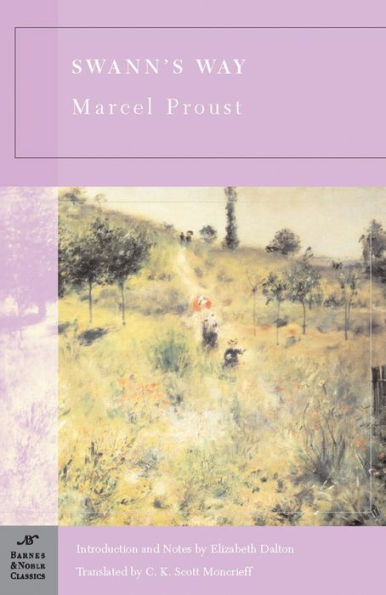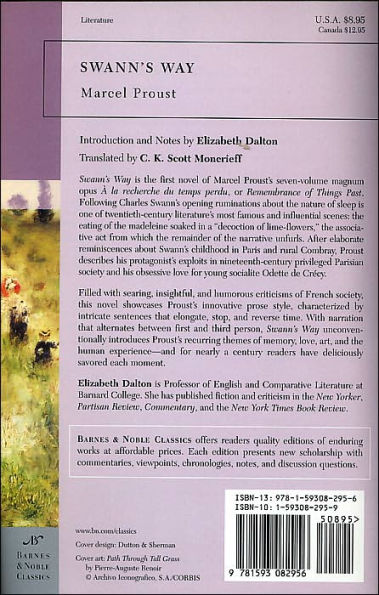- New introductions commissioned from today's top writers and scholars
- Biographies of the authors
- Chronologies of contemporary historical, biographical, and cultural events
- Footnotes and endnotes
- Selective discussions of imitations, parodies, poems, books, plays, paintings, operas, statuary, and films inspired by the work
- Comments by other famous authors
- Study questions to challenge the reader's viewpoints and expectations
- Bibliographies for further reading
- Indices & Glossaries, when appropriate
Swann’s Way is the first novel of Marcel Proust’s seven-volume magnum opus À la rechercheé du temps perdu, or Remembrance of Things Past. Following Charles Swann’s opening ruminations about the nature of sleep is one of twentieth-century literature’s most famous and influential scenes: the eating of the madeleine soaked in a “decoction of lime-flowers,” the associative act from which the remainder of the narrative unfurls. After elaborate reminiscences about Swann’s childhood in Paris and rural Combray, Proust describes his protagonist’s exploits in nineteenth-century privileged Parisian society and his obsessive love for young socialite Odette de Crécy.
Filled with searing, insightful, and humorous criticisms of French society, this novel showcases Proust’s innovative prose style, characterized by lengthy, intricate sentences that elongate, stop, and reverse time. With narration that alternates between first and third person, Swann’s Way unconventionally introduces Proust’s recurring themes of memory, love, art, and the human experience—and for nearly a century readers have deliciously savored each moment.
Elizabeth Dalton is Professor of English and Comparative Literature at Barnard College. She has published fiction and criticism in the New Yorker, Partisan Review, Commentary, and the New York Times Book Review.
- New introductions commissioned from today's top writers and scholars
- Biographies of the authors
- Chronologies of contemporary historical, biographical, and cultural events
- Footnotes and endnotes
- Selective discussions of imitations, parodies, poems, books, plays, paintings, operas, statuary, and films inspired by the work
- Comments by other famous authors
- Study questions to challenge the reader's viewpoints and expectations
- Bibliographies for further reading
- Indices & Glossaries, when appropriate
Swann’s Way is the first novel of Marcel Proust’s seven-volume magnum opus À la rechercheé du temps perdu, or Remembrance of Things Past. Following Charles Swann’s opening ruminations about the nature of sleep is one of twentieth-century literature’s most famous and influential scenes: the eating of the madeleine soaked in a “decoction of lime-flowers,” the associative act from which the remainder of the narrative unfurls. After elaborate reminiscences about Swann’s childhood in Paris and rural Combray, Proust describes his protagonist’s exploits in nineteenth-century privileged Parisian society and his obsessive love for young socialite Odette de Crécy.
Filled with searing, insightful, and humorous criticisms of French society, this novel showcases Proust’s innovative prose style, characterized by lengthy, intricate sentences that elongate, stop, and reverse time. With narration that alternates between first and third person, Swann’s Way unconventionally introduces Proust’s recurring themes of memory, love, art, and the human experience—and for nearly a century readers have deliciously savored each moment.
Elizabeth Dalton is Professor of English and Comparative Literature at Barnard College. She has published fiction and criticism in the New Yorker, Partisan Review, Commentary, and the New York Times Book Review.

Swann's Way (Barnes & Noble Classics Series)
512
Swann's Way (Barnes & Noble Classics Series)
512Related collections and offers

Product Details
| ISBN-13: | 9781593082956 |
|---|---|
| Publisher: | Barnes & Noble |
| Publication date: | 10/05/2005 |
| Series: | Barnes & Noble Classics Series |
| Pages: | 512 |
| Sales rank: | 420,073 |
| Product dimensions: | 5.18(w) x 8.00(h) x 1.28(d) |
About the Author






